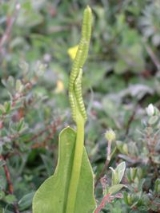
Ophioglossum
Encyclopedia
Ophioglossum is a genus of about 25-30 species of Ophioglossales
in the family Ophioglossaceae
, with a cosmopolitan
but primarily tropical and subtropical distribution. The name Ophioglossum comes from the Greek
, and means "snake-tongue".
Adders-tongues are so-called because the spore
-bearing stalk is thought to resemble a snake's
tongue. Each plant typically sends up a small, undivided leaf blade with netted venation, and the spore stalk forks from the leaf stalk, terminating in sporangia which are partially concealed within a structure with slitted sides. The plant grows from a central, budding, fleshy structure with fleshy, radiating roots. When the leaf blade is present, there is not always a spore stalk present, and the plants do not always send up a leaf, sometimes going for a year to a period of years living only under the soil, nourished by association with soil fungi
.
Ophioglossum has the highest chromosome
count of any known living organism, with 1,262 chromosomes. However, most species only have chromosomes in the 240-300+ range.
Ophioglossales
Ophioglossales are a small group of pteridophyte plants. Traditionally they are included in the division Pteridophyta, the ferns, originally as a family and later as the order Ophioglossales...
in the family Ophioglossaceae
Ophioglossaceae
Ophioglossaceae, the Adder's tongue family, is a family of ferns, currently thought to be most closely related to Psilotaceae, the two together comprising the class Psilotopsida as the sibling group to the rest of the ferns. The Ophioglossaceae is one of two groups of ferns traditionally known as...
, with a cosmopolitan
Cosmopolitan distribution
In biogeography, a taxon is said to have a cosmopolitan distribution if its range extends across all or most of the world in appropriate habitats. For instance, the killer whale has a cosmopolitan distribution, extending over most of the world's oceans. Other examples include humans, the lichen...
but primarily tropical and subtropical distribution. The name Ophioglossum comes from the Greek
Greek language
Greek is an independent branch of the Indo-European family of languages. Native to the southern Balkans, it has the longest documented history of any Indo-European language, spanning 34 centuries of written records. Its writing system has been the Greek alphabet for the majority of its history;...
, and means "snake-tongue".
Adders-tongues are so-called because the spore
Spore
In biology, a spore is a reproductive structure that is adapted for dispersal and surviving for extended periods of time in unfavorable conditions. Spores form part of the life cycles of many bacteria, plants, algae, fungi and some protozoa. According to scientist Dr...
-bearing stalk is thought to resemble a snake's
Snake
Snakes are elongate, legless, carnivorous reptiles of the suborder Serpentes that can be distinguished from legless lizards by their lack of eyelids and external ears. Like all squamates, snakes are ectothermic, amniote vertebrates covered in overlapping scales...
tongue. Each plant typically sends up a small, undivided leaf blade with netted venation, and the spore stalk forks from the leaf stalk, terminating in sporangia which are partially concealed within a structure with slitted sides. The plant grows from a central, budding, fleshy structure with fleshy, radiating roots. When the leaf blade is present, there is not always a spore stalk present, and the plants do not always send up a leaf, sometimes going for a year to a period of years living only under the soil, nourished by association with soil fungi
Fungus
A fungus is a member of a large group of eukaryotic organisms that includes microorganisms such as yeasts and molds , as well as the more familiar mushrooms. These organisms are classified as a kingdom, Fungi, which is separate from plants, animals, and bacteria...
.
Ophioglossum has the highest chromosome
Chromosome
A chromosome is an organized structure of DNA and protein found in cells. It is a single piece of coiled DNA containing many genes, regulatory elements and other nucleotide sequences. Chromosomes also contain DNA-bound proteins, which serve to package the DNA and control its functions.Chromosomes...
count of any known living organism, with 1,262 chromosomes. However, most species only have chromosomes in the 240-300+ range.

